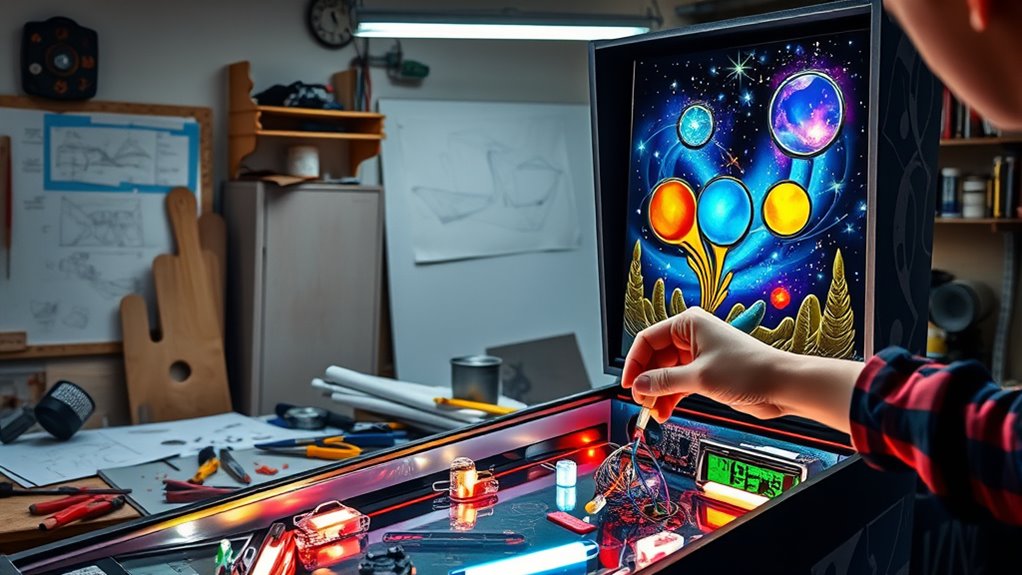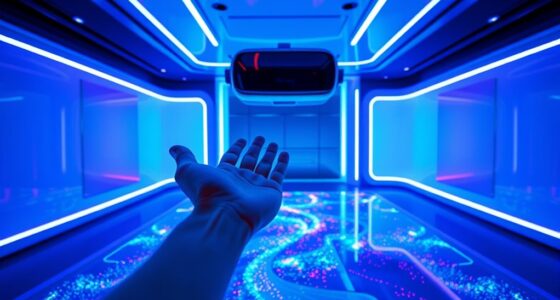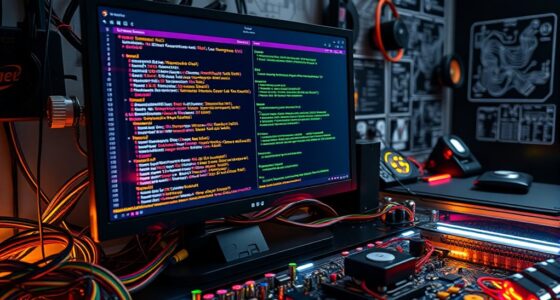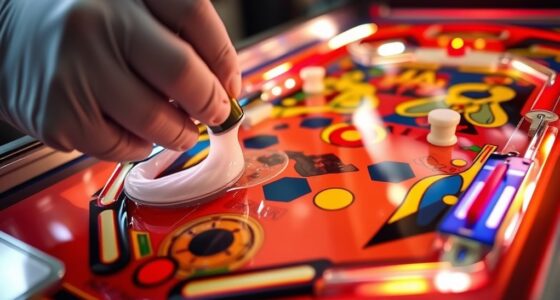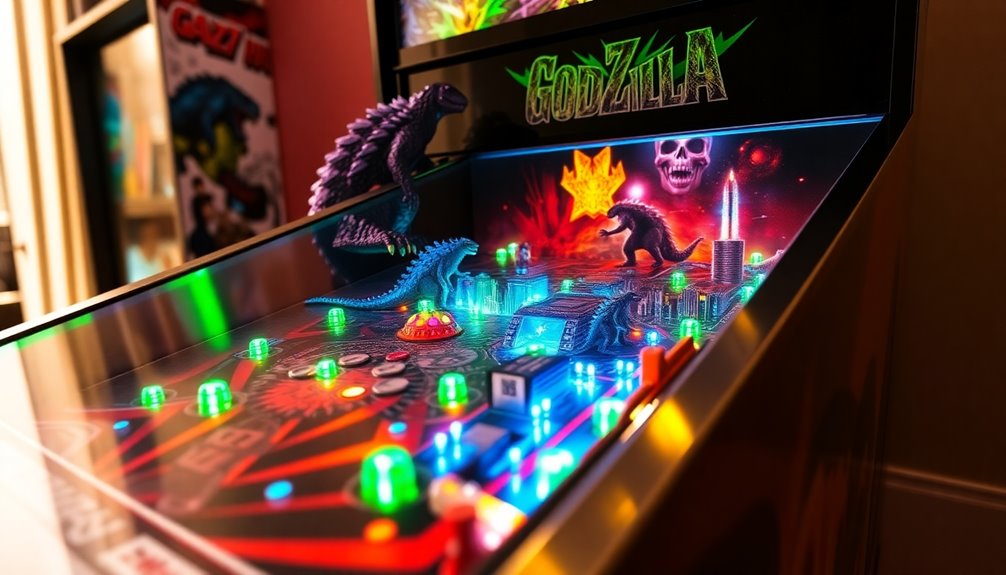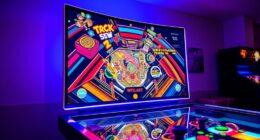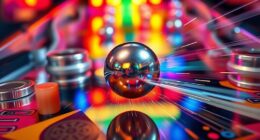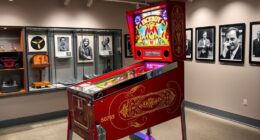Designing your own pinball machine involves blending engaging gameplay, eye-catching artwork, and smooth mechanics to create a fun, rewarding experience. Focus on developing a score system that rewards skill and offers exciting bonus features like multipliers or modes. Craft appealing visuals that guide players’ attention and enhance gameplay clarity. Fine-tune angles and mechanics to ensure reliable ball movement. If you keep exploring, you’ll discover how to balance aesthetics and functionality for a truly mesmerizing pinball machine.
Key Takeaways
- Define core gameplay mechanics, targets, and scoring systems to create engaging and skill-based play.
- Develop a cohesive visual theme with artwork that highlights gameplay objectives and enhances player experience.
- Integrate artwork with score mechanics to provide visual cues and improve gameplay clarity.
- Incorporate evolving features like multipliers, bonus rounds, and challenge layers to increase excitement and replayability.
- Test, refine, and ensure durability of both mechanics and artwork for a balanced, fun, and visually appealing pinball machine.

Designing a pinball machine is an exciting process that combines creativity, engineering, and game design. You’ll want to start by imagining how players will interact with your machine, focusing on the core gameplay experience. One of the most critical aspects is the score mechanics. You need to develop a system that rewards players for skillful play while keeping the game engaging. Think about how points are awarded—whether through hitting specific targets, completing sequences, or activating special features. Clear, rewarding score mechanics motivate players to keep trying and mastering your game. As you design these mechanics, consider how they can evolve throughout gameplay to add layers of challenge and excitement. This might include multipliers, bonus rounds, or progressive scoring that encourages players to aim for higher achievements. When it comes to artwork design, you’re creating the visual identity of your pinball machine, which directly influences its appeal. Your artwork should reflect a theme or story that draws players in, whether it’s a retro arcade vibe, a sci-fi universe, or a nostalgic motif. The artwork extends from the backglass and cabinet to the playfield itself, so every visual element must work together harmoniously. Bright colors, detailed illustrations, and thematic graphics help grab attention and make your game memorable. Remember, the artwork isn’t just decorative; it guides players’ eyes to important features like targets, lanes, and bonus areas. A well-designed artwork can enhance gameplay by clearly indicating objectives and special modes, making the experience more intuitive. As you plan your artwork, think about how it complements your score mechanics—visual cues should reinforce how to earn points or trigger special events. Additionally, studying optimal angles for pinball machines can help inform how your design influences gameplay performance and ball behavior. The design process involves iterating on these elements, testing how they interact, and refining to ensure your game is both fun and visually appealing. You’ll also want to take into account durability and ease of maintenance, especially for artwork that will see frequent contact. Ultimately, balancing engaging score mechanics with captivating artwork creates a cohesive experience that invites players to enjoy your pinball machine repeatedly. Combining these elements thoughtfully results in a game that’s not only exciting to play but also visually compelling. This integration is what transforms a basic design into a memorable arcade experience, capturing players’ attention and encouraging them to spend more time mastering your creation. By paying close attention to both the scoring system and artwork design, you set the foundation for a pinball machine that’s both fun and visually stunning, ensuring it stands out in any game room or arcade.
Frequently Asked Questions
What Are the Best Materials for Building a Durable Pinball Cabinet?
For a durable pinball cabinet, you should choose high-quality plywood or MDF, as they offer excellent cabinet durability and are easy to work with. Hardwood like oak or maple provides added strength and longevity, especially for structural parts. Avoid flimsy materials, and make certain proper material selection to prevent warping or damage over time. Using sturdy materials guarantees your pinball machine remains stable and resilient through countless plays.
How Can I Ensure My Machine’s Electronics Are Properly Protected?
Sure, because who wouldn’t want their precious electronics fried by a tiny lightning bolt? To protect your machine, you’ll want to guarantee solid electrical grounding and install reliable surge protection. Grounding prevents electrical mishaps, while surge protectors shield your components from unexpected power spikes. Combine both, and your electronics stay safe, letting you focus on perfecting that high score—not repairing fried circuits. Easy, right?
What Software Options Are Available for Designing Custom Game Rules?
You can explore software options like Visual Pinball, Future Pinball, or even custom tools like Python or C++ for digital design and rule scripting. These programs let you create and test your custom game rules easily, giving you control over gameplay mechanics. Many of these tools have user-friendly interfaces, tutorials, and scripting capabilities, so you can bring your unique pinball ideas to life and fine-tune your machine’s behavior effectively.
How Do I Troubleshoot Common Mechanical Issues During Assembly?
When troubleshooting mechanical issues during assembly, think of your pinball artwork and lighting effects as guiding lights. If a flipper feels stiff, check for misaligned or loose parts, gently realigning them. For lighting effects not activating, inspect wiring connections and fuses, ensuring everything’s snug. Keep your workspace organized, and test components step-by-step. Patience and careful observation help resolve issues smoothly, letting your machine shine as brightly as your creativity.
What Safety Precautions Should I Consider During Construction?
During construction, prioritize electrical safety by disconnecting power before working on wiring and wearing insulated gloves. Guarantee structural integrity by securely fastening all components and checking for stability. Keep your workspace organized to avoid accidents and use proper tools. Always follow safety guidelines, double-check connections, and consult manuals when unsure. Staying vigilant about electrical safety and structural integrity protects you from injuries and ensures your pinball machine functions safely and reliably.
Conclusion
Now that you’ve explored the basics of designing your own pinball machine, the real challenge begins. Every decision you make could transform your creation from a simple game into a legendary masterpiece—if you dare to push boundaries and think outside the box. Are you ready to bring your vision to life and leave players captivated? The future of your custom pinball machine depends on your boldness. What will you create when the final ball drops?
